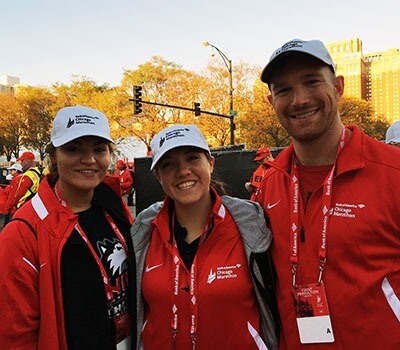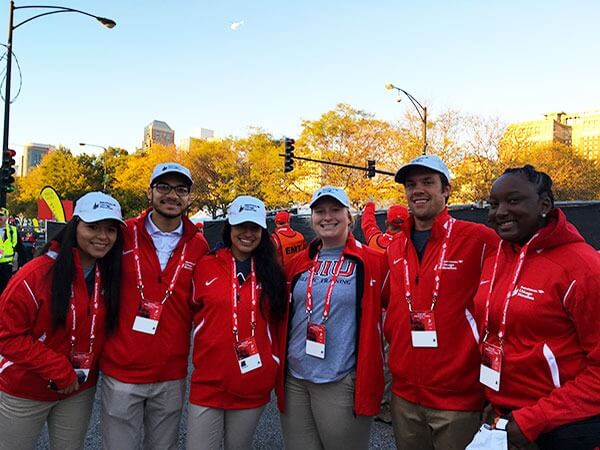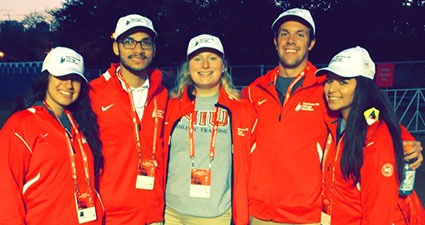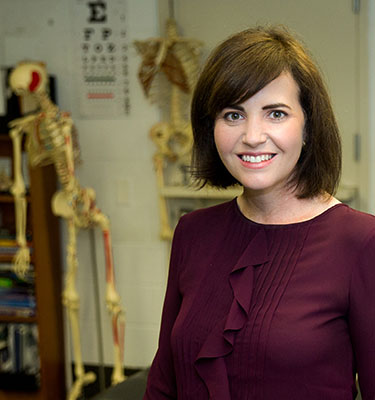 When runners finally cross the finish line and enter “the chute” at the end of the Chicago Marathon, their races aren’t quite over.
When runners finally cross the finish line and enter “the chute” at the end of the Chicago Marathon, their races aren’t quite over.
Chances are good that they might need medical assistance.
“Your body responds in a variety of ways after you run 26.2 miles,” says Kelly Potteiger, associate professor of Athletic Training in the NIU Department of Kinesiology and Physical Education.
One of the most common reasons for needing medical attention after the race is postural hypotension.
After so much high-level activity over a long period of time, Potteiger says, blood vessels dilate to supply ample amounts of energy to muscles. When those muscles suddenly stop, it can cause a runner’s blood pressure to crash. And, when this happens, runners can become dizzy and even lose consciousness.
Other reasons runners might collapse include their bodies shutting down from the heat; stress on their hearts; a lack of preparation; or other complications.
Triage is necessary along the quarter-mile passageway to swiftly gauge the current fitness and needs of all 45,000 runners – upright or not – to make sure these mostly amateur athletes are in possession of their mental and physical condition.
Enter “the sweep team,” which on Sunday, Oct. 8, included several students from NIU’s Athletic Trainers Student Association.
“We help to escort people who are in trouble through the chute and assess their capabilities,” Potteiger says. “If they’re losing cognitive function, or no longer have the ability to support themselves, we have to make a decision. Do we need to call a crash team? Can we get them to the medical tent? Or can they exit the chute on their own?”
 Potteiger joined the 13 students in what has become an every-October excursion to Balbo Drive and Columbus Avenue near Grant Park. Their bus left the NIU campus at 4 a.m.
Potteiger joined the 13 students in what has become an every-October excursion to Balbo Drive and Columbus Avenue near Grant Park. Their bus left the NIU campus at 4 a.m.
“It’s a great learning experience for our students to see how the medical response for a large event is organized,” Potteiger says. “That’s part of what athletic training is. If we’re working a football game, and a football player goes down, the athletic trainers run out there to do a quick evaluation and determine how we can safely get this player off the field to the sidelines for further evaluation.”
Students prepared by watching a training video and through mock simulations in the classroom.
The first-year students who made the trip were excited, if not a little nervous. “They practiced taking a history. They gained an understanding of how to take vitals and assess cognitive awareness,” she says. “It brings to light the different steps, and they take it more seriously when they know that they’re going to need to do all of this.”
Some of the students were Chicago Marathon veterans.
Corina Salinas, an athletic training major who volunteered for the first time in 2016, worked on a triage team. She and five others – one EMT, one nurse, two certified athletic trainers and another student – were on call when spotters situated in towers overlooking the course saw runners go down.
 “They didn’t need to be walked or stretched. They needed immediate attention,” Salinas says. “We went to evaluate. It was either, one, that they were fine and just needed to rest, or two, they needed intervention.”
“They didn’t need to be walked or stretched. They needed immediate attention,” Salinas says. “We went to evaluate. It was either, one, that they were fine and just needed to rest, or two, they needed intervention.”
Although nothing catastrophic happened Sunday, the autumn warmth did cause heat exhaustion and fainting in some runners. Salinas and her teammates quickly grabbed ice bags and cold towels to place directly on main arteries “to cool them down from the inside out.”
She enjoyed her 2017 trip more than the one that preceded it. “This year, I was more mentally prepared, and I felt more comfortable doing what I did,” she says. “I feel like I got more hands-on experience practicing the clinical skills that I’m learning at NIU.”
However, Salinas calls herself grateful for both years of experience.
Multitasking and collaboration provided good lessons in what is expected and required of athletic trainers, she says, whether they’re working with sports teams or with NASA. She also appreciated the glimpse at how the triage team worked together – and how the others relied on the athletic trainers for their specialized expertise.
“I really like putting myself in various stressful situations and seeing how I react to them if I’m able to keep my calm but still experience the rush of caring for a stressful medical situation,” Salinas says. “I have to act and react, and I have to do it effectively and efficiently. It makes me feel good knowing that I can.”
During the in-class debriefing Monday, the students scrutinized Sunday’s activities and discussed how they can apply those experiences to future clinical experiences, both as a student and eventually as a professional, athletic trainer.
Many will find jobs at high schools and colleges, where they will need to prepare for events such as cross country or track meets with only a few gallons of drinking water and one aid station. Working the marathon exposed them to grand-scale productions, however.
“It’s mindboggling to see the different resources behind the scenes, and our students get to see that,” Potteiger says. “Did you know that they run a 911 system out of a trailer at the marathon? It’s hooked right into 911! It’s really impressive.”
Sunday also offered a test in terms of endurance. Chicago Marathon runners in need of help come “in waves,” Potteiger says.
A majority of early finishers are the pros who know exactly how to prepare for — and run — marathons. Members of the triage team typically have little to do.
Many runners in the next wave, however, are pushing their bodies past their limits to notch good times – and the chute quickly gets busy for medical providers. The third phase brings those runners who have trained well, she says, and the medical traffic slows.
As the event nears its end, those who have been running for several hours begin to trickle in and tend to fill the medical tents.
Weather also plays a role in the medical response.

Kelly Potteiger
Potteiger was there in 2007 when the oppressive, 88-degree heat forced organizers to shut down the marathon in progress. She was there in 2006 – just the year before – when the cold and icy conditions caused one runner to slip and hit his head hard on the pavement.
She was also there in 2011 when a pregnant runner went into labor.
“You interact with so many patients throughout the day that you get really good and really fast at being able to tell who’s in danger and who’s going to be fine. You have people all along that spectrum,” she says.
“Our students can spend 10 minutes with someone. They could spend 30 minutes. It could be as short as five minutes. It’s as long as it takes,” she adds. “The year we had to shut it down, we had students sitting outside the medical tent just making conversation with runners to keep an eye on them and make sure they were lucid. Our students become very vested in their patients as they spend more time with them. They want to know that they’re OK, and they want to see them reunited with their families.”
